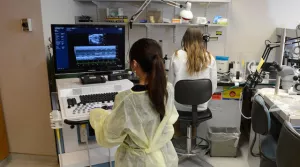The Molecular Cardiology Research Institute (MCRI) explores molecular and cellular events that are important in regulating normal cardiovascular physiology and cardiovascular function in disease. To investigate these molecular and cellular mechanisms as they relate to human biology, MCRI laboratories conduct extensive translational research that relies on a variety of novel models of cardiovascular disease.
The MCRI Mouse Physiology Core Facility is dedicated to the application of whole-animal mouse models to pursue questions related to the pathophysiology of cardiovascular disease. The MCRI has established a series of murine cardiovascular models that are in active use in both the MCRI and in laboratories around the U.S. and the world. Models developed at the MCRI include a mouse model of carotid injury; and a mouse model of chronic myocardial infarction. Phenotyping methods developed at the MCRI Mouse Core include a closed chest electrophysiology catheter-based procedure. The Mouse Core also routinely performs standard disease models and phenotyping assays relevant to cardiac and vascular physiology, including: models of ventricular pressure overload, ventricular pressure-volume loop analysis and cardiac echocardiography.

About
The facility is comprised of three separate rooms. The first and largest room is equipped with four independent and fully functional murine ‘operating stations’, each with a surgical stereomicroscope, tabletop gas anesthesia machine for rodent inhalation anesthesia, fiber optic lighting, temperature regulation with feedback control via rectal temperature monitoring, microsurgical instruments, heat pad and heat lamp, glass bead sterilizers, surgical supplies, shaver and weighing scales. In addition, there is a rodent respirator for use in open chest procedures and a Millar pressure volume hemodynamics area associated with one of these workstations. One of these four stations is primarily dedicated to closed chest survival electrophysiology studies. A fifth independent station houses a VisualSonics ultrasound machine with an associated tabletop gas anesthesia machine, a heated platform with EKG and a micromanipulator for injections. In a separate area, there is also a mouse exercise treadmill capable of exercising six mice simultaneously.
The second room is temperature and humidity-controlled and includes the DSI equipment necessary to perform continuous ambulatory telemetric EKG and hemodynamic monitoring along with constant measurement of animal temperature and activity. The current room capacity allows for simultaneous measurement of two groups of eight mice.
In the third room, there are two Kent Coda mouse tail cuff blood pressure analysis systems with laptop computers and capabilities of noninvasively measuring 12 mice simultaneously.
The Mouse Physiology Core is directed by Mark Aronovitz, MS, Assistant Professor of Medicine at Tufts University School of Medicine and a full-time member of the MCRI. Mr. Aronovitz is a highly experienced animal scientist with special expertise in animal physiology models. He serves on the Tufts University Institutional Animal Care and Use Committee.
Dr. Robert Blanton is an Assistant Professor of Medicine at Tufts University School of Medicine, an Attending Cardiologist at Tufts Medical Center and an Investigator in the MCRI. As an investigator, he serves as the Scientific/Medical Director of the Mouse Physiology Core working closely with investigators and Mr. Aronovitz on research plans, policies and procedures.